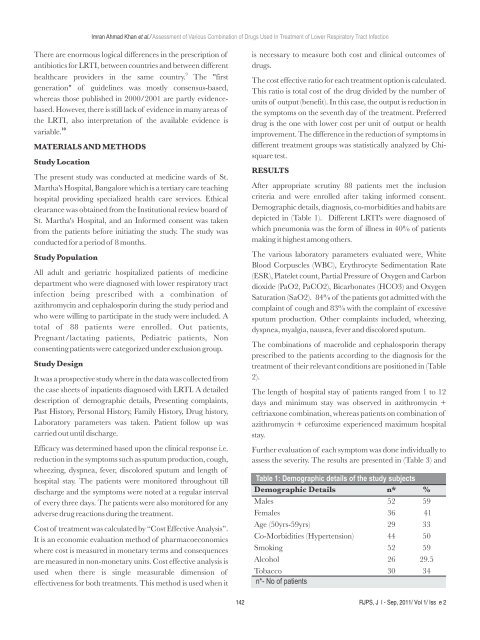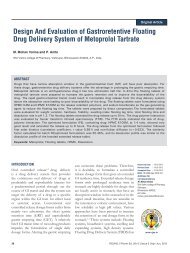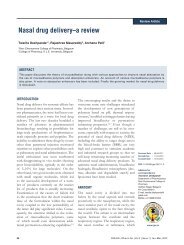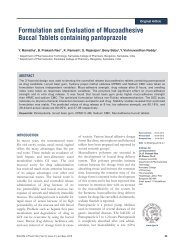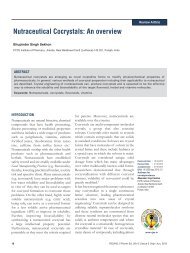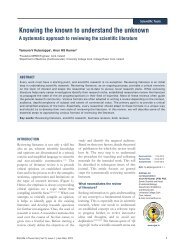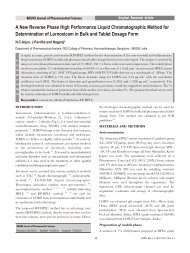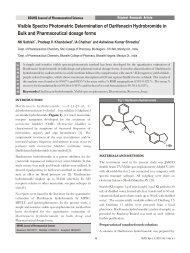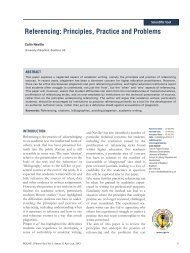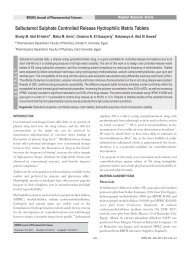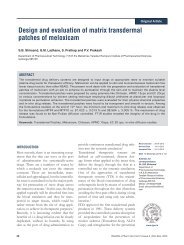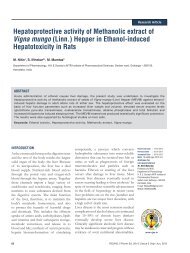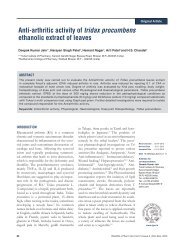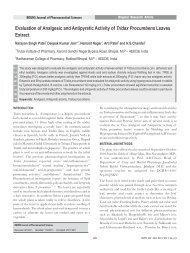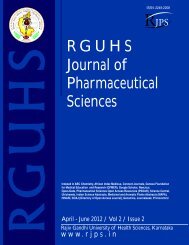Chitosan Loaded Mucoadhesive Microspheres of Gliclazide - Journal
Chitosan Loaded Mucoadhesive Microspheres of Gliclazide - Journal
Chitosan Loaded Mucoadhesive Microspheres of Gliclazide - Journal
You also want an ePaper? Increase the reach of your titles
YUMPU automatically turns print PDFs into web optimized ePapers that Google loves.
There are enormous logical differences in the prescription <strong>of</strong><br />
antibiotics for LRTI, between countries and between different<br />
9<br />
healthcare providers in the same country. The "first<br />
generation" <strong>of</strong> guidelines was mostly consensus-based,<br />
whereas those published in 2000/2001 are partly evidencebased.<br />
However, there is still lack <strong>of</strong> evidence in many areas <strong>of</strong><br />
the LRTI, also interpretation <strong>of</strong> the available evidence is<br />
10<br />
variable.<br />
MATERIALS AND METHODS<br />
Study Location<br />
The present study was conducted at medicine wards <strong>of</strong> St.<br />
Martha's Hospital, Bangalore which is a tertiary care teaching<br />
hospital providing specialized health care services. Ethical<br />
clearance was obtained from the Institutional review board <strong>of</strong><br />
St. Martha's Hospital, and an Informed consent was taken<br />
from the patients before initiating the study. The study was<br />
conducted for a period <strong>of</strong> 8 months.<br />
Study Population<br />
All adult and geriatric hospitalized patients <strong>of</strong> medicine<br />
department who were diagnosed with lower respiratory tract<br />
infection being prescribed with a combination <strong>of</strong><br />
azithromycin and cephalosporin during the study period and<br />
who were willing to participate in the study were included. A<br />
total <strong>of</strong> 88 patients were enrolled. Out patients,<br />
Pregnant/lactating patients, Pediatric patients, Non<br />
consenting patients were categorized under exclusion group.<br />
Study Design<br />
Imran Ahmad Khan et al./ Assessment <strong>of</strong> Various Combination <strong>of</strong> Drugs Used In Treatment <strong>of</strong> Lower Respiratory Tract Infection<br />
It was a prospective study where in the data was collected from<br />
the case sheets <strong>of</strong> inpatients diagnosed with LRTI. A detailed<br />
description <strong>of</strong> demographic details, Presenting complaints,<br />
Past History, Personal History, Family History, Drug history,<br />
Laboratory parameters was taken. Patient follow up was<br />
carried out until discharge.<br />
Efficacy was determined based upon the clinical response i.e.<br />
reduction in the symptoms such as sputum production, cough,<br />
wheezing, dyspnea, fever, discolored sputum and length <strong>of</strong><br />
hospital stay. The patients were monitored throughout till<br />
discharge and the symptoms were noted at a regular interval<br />
<strong>of</strong> every three days. The patients were also monitored for any<br />
adverse drug reactions during the treatment.<br />
Cost <strong>of</strong> treatment was calculated by “Cost Effective Analysis”.<br />
It is an economic evaluation method <strong>of</strong> pharmacoeconomics<br />
where cost is measured in monetary terms and consequences<br />
are measured in non-monetary units. Cost effective analysis is<br />
used when there is single measurable dimension <strong>of</strong><br />
effectiveness for both treatments. This method is used when it<br />
142<br />
is necessary to measure both cost and clinical outcomes <strong>of</strong><br />
drugs.<br />
The cost effective ratio for each treatment option is calculated.<br />
This ratio is total cost <strong>of</strong> the drug divided by the number <strong>of</strong><br />
units <strong>of</strong> output (benefit). In this case, the output is reduction in<br />
the symptoms on the seventh day <strong>of</strong> the treatment. Preferred<br />
drug is the one with lower cost per unit <strong>of</strong> output or health<br />
improvement. The difference in the reduction <strong>of</strong> symptoms in<br />
different treatment groups was statistically analyzed by Chi-<br />
square test.<br />
RESULTS<br />
After appropriate scrutiny 88 patients met the inclusion<br />
criteria and were enrolled after taking informed consent.<br />
Demographic details, diagnosis, co-morbidities and habits are<br />
depicted in (Table 1). Different LRTI's were diagnosed <strong>of</strong><br />
which pneumonia was the form <strong>of</strong> illness in 40% <strong>of</strong> patients<br />
making it highest among others.<br />
The various laboratory parameters evaluated were, White<br />
Blood Corpuscles (WBC), Erythrocyte Sedimentation Rate<br />
(ESR), Platelet count, Partial Pressure <strong>of</strong> Oxygen and Carbon<br />
dioxide (PaO2, PaCO2), Bicarbonates (HCO3) and Oxygen<br />
Saturation (SaO2). 84% <strong>of</strong> the patients got admitted with the<br />
complaint <strong>of</strong> cough and 83% with the complaint <strong>of</strong> excessive<br />
sputum production. Other complaints included, wheezing,<br />
dyspnea, myalgia, nausea, fever and discolored sputum.<br />
The combinations <strong>of</strong> macrolide and cephalosporin therapy<br />
prescribed to the patients according to the diagnosis for the<br />
treatment <strong>of</strong> their relevant conditions are positioned in (Table<br />
2).<br />
The length <strong>of</strong> hospital stay <strong>of</strong> patients ranged from 1 to 12<br />
days and minimum stay was observed in azithromycin +<br />
ceftriaxone combination, whereas patients on combination <strong>of</strong><br />
azithromycin + cefuroxime experienced maximum hospital<br />
stay.<br />
Further evaluation <strong>of</strong> each symptom was done individually to<br />
assess the severity. The results are presented in (Table 3) and<br />
Table 1: Demographic details <strong>of</strong> the study subjects<br />
Demographic Details n* %<br />
Males 52 59<br />
Females 36 41<br />
Age (50yrs-59yrs) 29 33<br />
Co-Morbidities (Hypertension) 44 50<br />
Smoking 52 59<br />
Alcohol 26 29.5<br />
Tobacco<br />
n*- No <strong>of</strong> patients<br />
30 34<br />
RJPS, Jul - Sep, 2011/ Vol 1/ Issue 2


